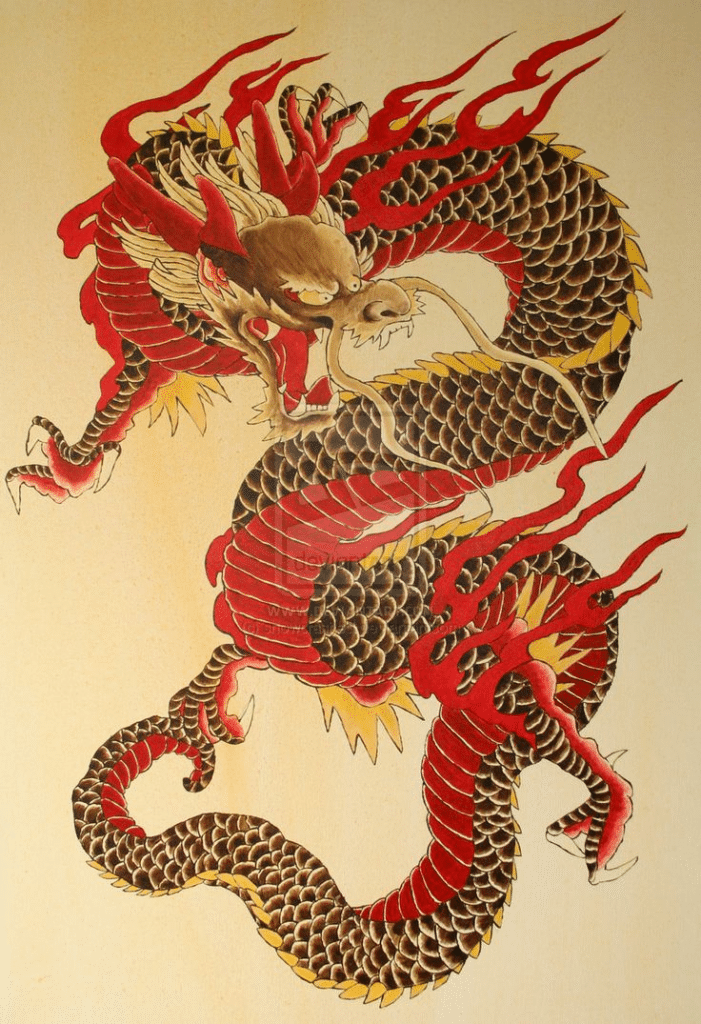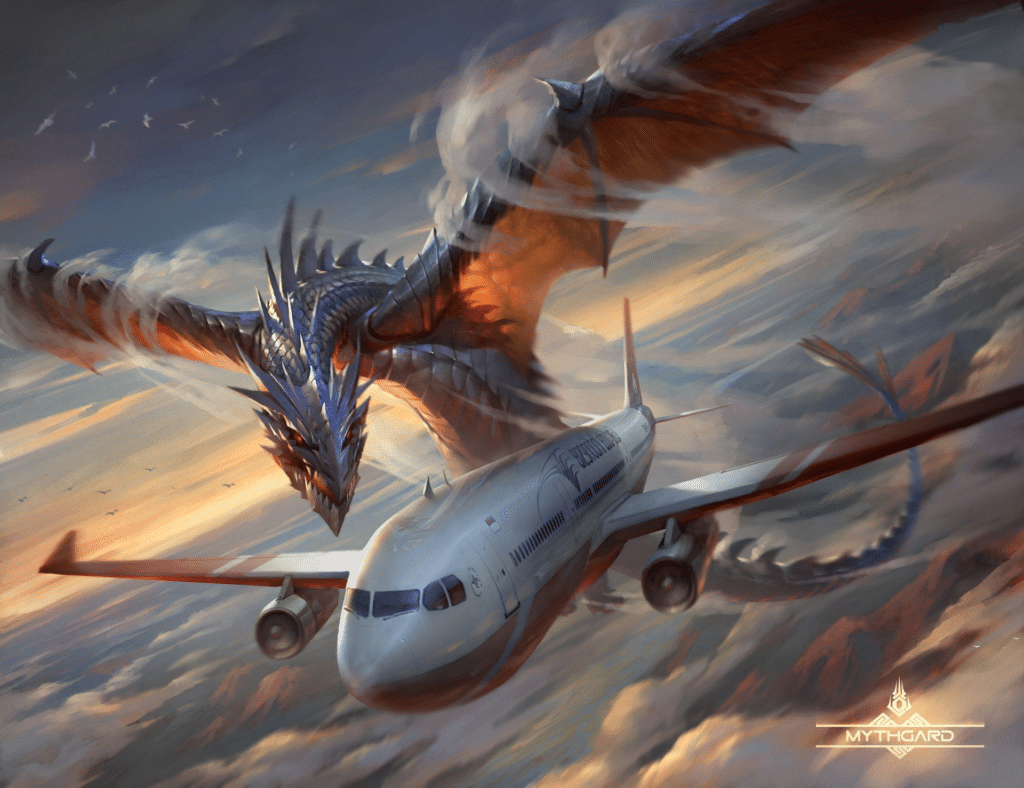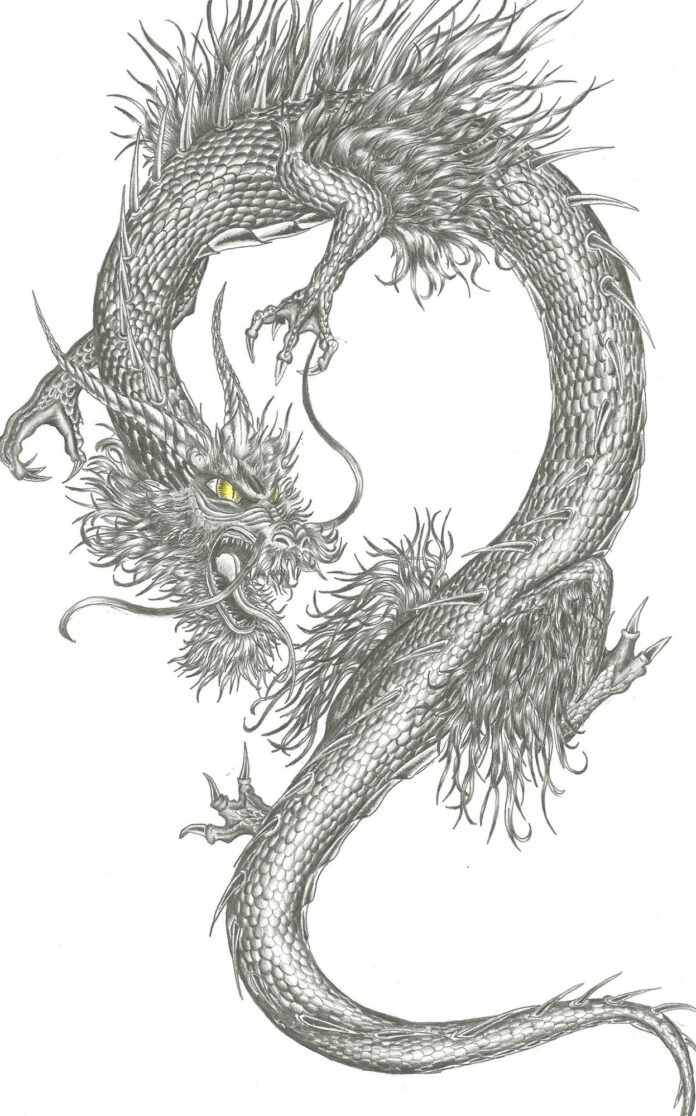Dragon tattoos are a popular and timeless choice in the world of body art, revered for their mythical allure and cultural significance. Dragon tattoos are found in various forms across different cultures and have diverse meanings and aesthetic styles.

This article will explore the origins, symbolism, artistic representation, design variety, considerations for choosing a design, the tattooing process, and aftercare tips for dragon tattoos.
Related: 10+ Patchwork Tattoo Ideas
Origins of Dragon Tattoos Across Different Cultures

Dragons have been a prominent symbol in various cultures throughout history. In Chinese culture, dragons are revered as benevolent creatures associated with power, authority, and good fortune.
In contrast, European cultures often depict dragons as menacing, representing chaos and danger. In Japanese culture, dragons symbolize wisdom, strength, and balance.
Related: 8 Famous Paintings With Hidden Meanings
What Does a Dragon Tattoo Symbolize?
The symbolism of a dragon tattoo can vary based on cultural beliefs and personal interpretations. Generally, a dragon is seen as a symbol of strength, power, protection, and wisdom. It can also represent transformation, resilience, and the ability to overcome challenges.
How Dragon Tattoo Symbols Translate into Tattoo Art
Tattoo artists interpret the symbolic meanings of dragons into visually stunning designs. Elements like scales, claws, wings, and overall posture can emphasize different characteristics.
For example, a dragon with its head held high may symbolize confidence and power, while a coiled dragon might represent protection.
Dragon Tattoo Symbolism

The dragon, a mythical creature known for its serpentine or reptilian form, has a distinct symbolism in different cultures. Its portrayal varies from being a symbol of malevolence and chaos to embodying benevolence, wisdom, and strength.
When transformed into tattoo art, the symbolism takes on a visual and personal dimension, blending ancient tales with individual narratives.
Related: Meet The 10 Most Famous Artists In History
Traditional Eastern Dragons: Guardians of Power and Prosperity

Based on Asian mythology, it features long, serpentine bodies and benevolent traits.
In Eastern cultures, particularly in China and Japan, the dragon is revered as a benevolent and powerful entity associated with good fortune, power, and prosperity.
The Eastern dragon, often depicted with a long, sinuous body and multiple claws, symbolizes potent and auspicious forces of nature. Its presence is believed to bring luck and harmony, making it a popular choice for tattoos to attract positive energies into one’s life.
European Dragons: Conquerors of Darkness

Often portrayed as fierce, fire-breathing creatures with large wings and sharp claws.
Contrary to the benevolent image in the East, European folklore paints dragons as formidable adversaries.
They are often depicted as fire-breathing creatures, embodying chaos, destruction, and malevolence. In this context, a dragon tattoo may represent overcoming adversity, facing one’s fears, or vanquishing inner demons.
Dragons in Japanese Culture: Wisdom and Balance

A fusion of different Asian dragon designs, combining features from Chinese, Japanese, and other Eastern mythologies.
In Japanese mythology, dragons are seen as symbols of wisdom, balance, and good fortune. The Japanese dragon, known as “Ryū” or “Tatsu,” is revered for its strength and connection to the natural world.
When translated into a tattoo, the Japanese dragon often features intricate designs with distinctive, flowing lines and vibrant colours, capturing the essence of balance and wisdom.
Celtic and Norse Dragons: Guardians of Knowledge

Typically associated with bodies of water, possessing fluid and graceful characteristics.
In Celtic and Norse cultures, dragons are revered as protectors and bearers of wisdom and knowledge. Celtic dragons, often intertwined with knots and loops, are seen as guardians of sacred spaces and revered for their wisdom and guidance.
A dragon tattoo in this style may represent protection, intellect, and a deep spiritual connection.
Read Also: Top 30 Beautiful Octopus Tattoos Design Ideas
Modern Interpretations: Personal Power and Freedom

Utilizing bold, black lines and geometric patterns to create a tribal aesthetic.
In contemporary tattoo art, dragon symbolism has evolved to reflect personal empowerment, individualism, and freedom. Modern dragon tattoos often combine elements from various cultural representations, allowing for a fusion of meanings.
Individuals may choose a dragon tattoo to embody their strength, resilience, and ability to rise above challenges.
Factors to Consider When Choosing a Dragon Tattoo Design
- Size: Consider the area of your body and how much space you want the tattoo to cover. Smaller designs may fit on wrists or ankles, while larger ones may be suitable for the back or chest.
- Placement: The placement can influence the symbolism and visibility of the tattoo. Common placements include the back, forearm, calf, or chest.
- Colour: The colour palette can enhance the overall appeal of the tattoo. Traditional colours like red, black, and green are popular, but modern designs often incorporate a broader spectrum.
- Style: Choose a style that resonates with you, whether it’s realistic, tribal, watercolour, or a blend of different styles.
Related: Top 30 Barbed Wire Tattoo Design Ideas
Process of Getting a Dragon Tattoo

Getting a tattoo involves several steps:
- Consultation: Discuss your ideas with a tattoo artist who can provide insights and help refine your design.
- Design Approval: Review and approve the final design before the tattooing process begins.
- Preparation: The tattoo area is cleaned, and a stencil of the design is applied to guide the artist.
- Tattooing: The artist uses needles to insert ink into the skin, following the stencil to create the design.
- Aftercare Instructions: The artist provides guidance on how to care for the tattoo during the healing process.
Dos and Don’ts: Caring for Your Dragon Tattoo

Dos:
- Keep it Clean: Gently wash the tattoo with mild soap and water, then pat dry with a clean towel.
- Moisturize: Apply a thin layer of tattoo-specific ointment or unscented lotion to keep the tattoo hydrated.
- Protect from the Sun: Avoid exposing the tattoo to direct sunlight and apply sunscreen when necessary to prevent fading.
- Stay Hydrated: Drink plenty of water to keep your skin healthy, aiding in healing.
Don’ts:
- Avoid Picking or Scratching: Refrain from picking at scabs or scratching the tattoo, as this can damage the healing skin and affect the outcome.
- No Swimming or Saunas: Avoid swimming pools, hot tubs, or saunas until the tattoo is fully healed to prevent infections.
- Limit Sun Exposure: Direct sunlight can fade the tattoo and hinder the healing process, so keep it covered or use sunscreen.
See Also: 40 Rose Tattoos for Men
Aftercare Tips to Ensure the Longevity and Vibrancy of the Tattoo

- Follow Aftercare Instructions: Adhere to the aftercare guidelines provided by your tattoo artist to ensure proper healing.
- Regular Touch-ups: Consider touch-up sessions with your artist to maintain the vibrancy and sharpness of the tattoo over time.
- Healthy Lifestyle: Maintain a healthy diet and lifestyle, as overall well-being contributes to the appearance and longevity of your tattoo.
Celebrities with a Dragon Tattoo
While many celebrities have embraced the beauty of dragon tattoos, one notable figure is Angelina Jolie. Jolie, known for her love of body art, has a striking dragon tattoo on her upper left arm.
The intricate design showcases a powerful dragon, embodying the strength and resilience that dragons symbolize.
Related: What to Do After Wisdom Teeth Removal
Conclusion
Dragon tattoos have transcended cultural boundaries to become a universal symbol of power, strength, and transformation. The rich history and diverse interpretations of dragons across different cultures have inspired a wide range of artistic expressions in the world of tattooing.
When considering a dragon tattoo, it’s important to carefully choose the design, size, placement, colour, and style that resonate with you and to prioritize proper aftercare to ensure the longevity and vibrancy of this captivating ink.
As demonstrated by celebrities like Angelina Jolie, a dragon tattoo is not merely a piece of art; it’s a statement of inner strength and the embodiment of mythical prowess.
If there are any questions, post them below.
FAQ
What does the dragon tattoo mean in Christianity?
The dragon tattoo does not have a specific meaning in Christianity. In fact, there are very few references to dragons in the Bible. The most well-known instance is in the Book of Revelation, where Satan is described as a “great red dragon.” This description has led some Christians to associate dragons with evil and temptation.
However, there are also other interpretations of dragons in Christianity. Some Christians believe that dragons can represent the power of God and the strength of faith. Others believe that dragons can represent the challenges and obstacles that Christians face in their lives.
Ultimately, the meaning of a dragon tattoo is up to the individual. Some people may get a dragon tattoo simply because they like how it looks. Others may choose to get a dragon tattoo because it has a personal meaning to them.
There is no right or wrong answer when it comes to the meaning of a dragon tattoo in Christianity. It is important to remember that the Bible is not a style guide, and there is no one way to be a Christian.
What does the tiger and dragon tattoo mean?
The tiger and dragon tattoo is a popular design with various meanings. In Chinese culture, the tiger and dragon are two of the four sacred creatures, and they are often depicted together as symbols of balance and harmony. The tiger is associated with the yin (feminine) energy, while the dragon is associated with the yang (masculine) energy. Together, they represent the duality of nature and the importance of balance in all things.
In Japanese culture, the tiger and dragon tattoo are also popular symbols. The tiger is often seen as a symbol of strength, courage, and ferocity. The dragon is seen as a symbol of wisdom, power, and good luck. Together, they represent the ideal combination of strength and wisdom.
Some people choose to get a tiger and dragon tattoo simply because they like the way it looks. Others choose to get this tattoo because it has a personal meaning to them. For example, someone who has overcome a difficult challenge in their life may choose to get a tiger and dragon tattoo to represent their strength and resilience.
Here are some of the most common meanings of the tiger and dragon tattoo:
Balance and harmony
Yin and yang
Strength and wisdom
Courage and ferocity
Good luck and prosperity
Overcoming challenges
Duality of nature
Is a dragon a lucky symbol?
Yes, the dragon is a lucky symbol in many cultures, especially in Chinese culture. In China, the dragon is associated with power, strength, wisdom, and good luck. It is also believed to be the protector of rain and fertility.
The dragon is one of the twelve animals in the Chinese zodiac, and people born in the year of the dragon are said to be lucky, intelligent, and successful. The dragon is also a popular symbol in feng shui, and it is believed to bring good luck and prosperity to homes and businesses.
In other cultures, such as Japanese and Korean culture, the dragon is also seen as a lucky symbol. The Japanese dragon is often depicted as a wise and benevolent creature, and it is associated with good luck and prosperity. The Korean dragon is also seen as a lucky symbol and is often depicted as a protector of the people.
While the dragon is not a lucky symbol in all cultures, it is generally seen as a positive and auspicious creature. The dragon is associated with power, strength, wisdom, and good luck in many cultures.
Here are some examples of how the dragon is used as a lucky symbol in different cultures:
In China, the dragon is often used in advertising and marketing to promote good luck and prosperity.
In Japan, the dragon is often used in festivals and celebrations to bring good luck and happiness.
In Korea, the dragon is often used in architecture and design to ward off evil spirits and protect the people.
If you are looking for a lucky symbol, the dragon is a great option to consider. It is a powerful and auspicious creature that is associated with good luck and prosperity in many cultures.
What is the spiritual dragon symbol?
The spiritual dragon symbol is a complex and multifaceted one. The dragon is associated with power, wisdom, and transformation in many cultures. It is also seen as a protector of sacred knowledge and the gateway to other realms.
On a spiritual level, the dragon can represent our own inner power and potential. It can also represent the challenges and obstacles that we face on our spiritual journey. When we encounter the dragon in our dreams or visions, it can be a sign that we are ready to face our fears and transform ourselves.
The dragon can also represent the divine feminine energy. It is often depicted as a serpent or a winged creature, which are both symbols of the feminine. The dragon’s fire breath can represent the creative power of the feminine and the power of transformation and destruction.
Here are some of the specific spiritual meanings of the dragon symbol:
Inner power and potential
Challenges and obstacles on the spiritual journey
Transformation and rebirth
The divine feminine energy
Creative power
Power of destruction and regeneration
Sacred knowledge
Gateway to other realms
Protector of the sacred
If you feel drawn to the dragon symbol, exploring what it means to you personally is important. The dragon is a powerful and mysterious creature that can teach us a lot about our inner power and potential.
Here are some ways to connect with the spiritual dragon symbol:
Meditate on the dragon symbol and ask it to guide you on your spiritual journey.
Journal about your dreams and visions of dragons.
Read books and articles about the dragon symbol.
Visit places where dragons are revered, such as temples or museums.
Wear or carry dragon jewellery or amulets.
Create your own dragon art or music.
Allow the dragon symbol to inspire you and guide you on your spiritual path.





